| Listing 1 - 10 of 15 | << page >> |
Sort by
|
Book
Year: 2002 Publisher: Paris: L'Harmattan,
Abstract | Keywords | Export | Availability | Bookmark
 Loading...
Loading...Choose an application
- Reference Manager
- EndNote
- RefWorks (Direct export to RefWorks)
La violence est un thème littéraire et artistique particulièrement problématique : peut-on en effet la montrer ? Elle confronte à l'innommable, se présente comme la tache aveugle de l'expérience, là où il n'y a plus rien à dire. Pourquoi l'art et la littérature s'obstinent-ils dès lors, tant dans le domaine sacré que profane, à sa représentation ? Et comment ? Ce livre éclaire ces questions en montrant que la création littéraire ou artistique s'inscrit par nature au cœur d'une violence, celle de l'incapacité à dire ou à montrer, tandis qu'une autre puissance fait que l'on dépasse ce mutisme. La représentation de la violence est bien une douleur ajoutée ; elle donne accès à un " autre lieu ", qui n'est pas la vie mais l'imaginaire. Posée dans le cadre d'un travail de création, la violence appelle nécessairement une interprétation qui va au-delà de ce qui est montré d'un point de vue littéral ; plus que tout autre objet, elle souligne dès lors le geste artistique. Or celui-ci s'avère susceptible de partager l'émotion, de signifier la révolte et d'esquisser un sens possible à l'horreur. Cet ouvrage propose un jeu de regards croisés sur ce phénomène des spécialistes de diverses disciplines des sciences humaines (histoire, théologie, étude des arts, des lettres et des médias, psychanalyse, politologie...) explorent les manifestations, monstrations, définitions, conjurations de la violence. L'effort transdisciplinaire s'est effectué ici grâce à deux notions : la représentation et la ritualisation, qui s'avèrent, en définitive, solidaires.
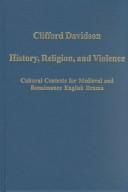
ISBN: 0860788822 Year: 2002 Publisher: Aldershot ; Burllington ; Singapore Ashgate
Abstract | Keywords | Export | Availability | Bookmark
 Loading...
Loading...Choose an application
- Reference Manager
- EndNote
- RefWorks (Direct export to RefWorks)
Book
Abstract | Keywords | Export | Availability | Bookmark
 Loading...
Loading...Choose an application
- Reference Manager
- EndNote
- RefWorks (Direct export to RefWorks)

ISBN: 1283205637 9786613205636 1441136738 9781441136732 9781283205634 0826452450 9780826452450 Year: 2002 Publisher: New York Continuum
Abstract | Keywords | Export | Availability | Bookmark
 Loading...
Loading...Choose an application
- Reference Manager
- EndNote
- RefWorks (Direct export to RefWorks)
This is part of a new series of guides to contemporary novels. The aim of the series is to give readers accessible and informative introductions to some of the most popular, most acclaimed and most influential novels of recent years GÇô from GÇÿThe Remains of the DayGÇÖ to GÇÿWhite TeethGÇÖ. A team of contemporary fiction scholars from both sides of the Atlantic has been assembled to provide a thorough and readable analysis of each of the novels in question.
Serial murderers in literature. --- Violence in literature. --- Ellis, Bret Easton.

ISBN: 0813031273 9780813031279 9780813024424 0813024420 Year: 2002 Publisher: Gainesville : UPF,
Abstract | Keywords | Export | Availability | Bookmark
 Loading...
Loading...Choose an application
- Reference Manager
- EndNote
- RefWorks (Direct export to RefWorks)
''Challenges readers to acknowledge the extent to which violence figured in medieval texts and, with this recognition, to reconsider what the works teach us not only about the treatments and troping of victims in the medieval world but also how these patterns are a part of the social history of domestic violence.
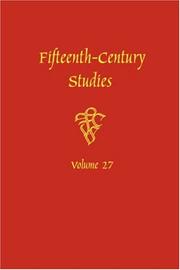
ISBN: 9781782044604 1571130810 1782044604 9781571130815 Year: 2002 Publisher: Rocherster: Camden House,
Abstract | Keywords | Export | Availability | Bookmark
 Loading...
Loading...Choose an application
- Reference Manager
- EndNote
- RefWorks (Direct export to RefWorks)
Founded in 1977 as the publication organ for the Fifteenth-Century Symposium, Fifteenth-Century Studies has appeared annually since then. It publishes essays on all aspects of life in the fifteenth century, including literature, drama, history, philosophy, art, music, religion, science, and ritual and custom. The editors strive to do justice to the most contested medieval century, a period that has long been the stepchild of research. The fifteenth century defies consensus on fundamental issues: some scholars dispute, in fact, whether it belonged to the middle ages at all, arguing that it was a period of transition, a passage to modern times. At issue, therefore, is the very tenor of an age that stood under the influence of Gutenberg, Columbus, the Devotio Moderna,, and Humanism.Volume 27 is a special issue offering a selection of outstanding papers on violence that will interest students of medieval history and the early Renaissance, the humanities, art history, sociology, anthropology, and even the general reader. The articles highlight warfare and justice, violence in family and milieu (court, town, village, and forest), hagiography, ethnicity and xenophobia, gender relations and sexual violence, brutality on the stage, and the relation of text and image in the depiction of violence. Edelgard E. DuBruck is professor in the Modern Languages Department at Marygrove College in Detroit; Yael Even is associate professor of Art and Art History at the University of Missouri, St. Louis.
Culture --- Fifteenth century. --- Literature, Medieval --- History --- History and criticism. --- Violence in literature.

ISBN: 0813024420 Year: 2002 Publisher: Gainesville, Tallahassee University Press of Florida
Abstract | Keywords | Export | Availability | Bookmark
 Loading...
Loading...Choose an application
- Reference Manager
- EndNote
- RefWorks (Direct export to RefWorks)
''Challenges readers to acknowledge the extent to which violence figured in medieval texts and, with this recognition, to reconsider what the works teach us not only about the treatments and troping of victims in the medieval world but also how these patterns are a part of the social history of domestic violence.
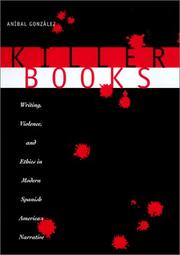
ISBN: 0292728395 029271808X 0292770111 Year: 2002 Publisher: Austin, Tex. University of Texas Press
Abstract | Keywords | Export | Availability | Bookmark
 Loading...
Loading...Choose an application
- Reference Manager
- EndNote
- RefWorks (Direct export to RefWorks)
Fiction --- Spanish-American literature --- anno 1800-1999 --- Authorship --- Ethics in literature. --- Literature and society --- Spanish American fiction --- Violence in literature. --- Social aspects. --- History and criticism
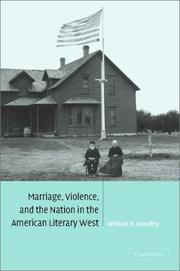
ISBN: 110713451X 128016140X 0511120818 1139148370 0511061021 0511054696 0511308299 0511485522 0511069480 9780511061028 9780511069482 9780511120817 9780521816670 052181667X 9786610161409 6610161402 9781139148375 9780511054693 9780511308291 9780511485527 9780521093422 0521093422 Year: 2002 Publisher: Cambridge, UK ; New York : Cambridge University Press,
Abstract | Keywords | Export | Availability | Bookmark
 Loading...
Loading...Choose an application
- Reference Manager
- EndNote
- RefWorks (Direct export to RefWorks)
In Marriage, Violence and the Nation in the American Literary West, William R. Handley examines literary interpretations of the Western American past. Handley argues that although scholarship provides a narrative of western history that counters optimistic story of frontier individualism by focusing on the victims of conquest, twentieth-century American fiction tells a different story of intra-ethnic violence surrounding marriages and families. He examines works of historiography,as well as writing by Zane Grey, Willa Cather, Wallace Stegner and Joan Didion among others, to argue that these works highlight white Americans' anxiety about what happens to American 'character' when domestic enemies such as Indians and Mormon polygamists, against whom the nation had defined itself in the nineteenth century, no longer threaten its homes. Handley explains that once its enemies are gone, imperialism brings violence home in retrospective narratives that allegorise national pasts and futures through intimate relationships.
American literature --- Novelists, American --- Domestic fiction, American --- National characteristics, American, in literature. --- Western stories --- Frontier and pioneer life in literature. --- Family violence in literature. --- Women pioneers in literature. --- Marriage in literature. --- Violence in literature. --- American novelists --- History and criticism. --- Homes and haunts --- West (U.S.) --- Intellectual life. --- In literature. --- Family violence in literature --- Frontier and pioneer life in literature --- Marriage in literature --- National characteristics, American, in literature --- Violence in literature --- Women pioneers in literature --- History and criticism --- Arts and Humanities --- Literature --- Domestic fiction [American ] --- National characteristics [American ] --- West [U.S.] in literature --- Cather, Willa Sibert --- Criticism and interpretation --- Stegner, Wallace Earle --- Didion, Joan --- Fitzgerald, Francis Scott --- Grey, Zane --- Wister, Owen --- Turner, Frederick Jackson
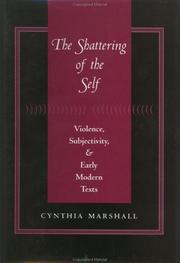
ISBN: 0801876435 9780801876431 0801867789 9780801867781 Year: 2002 Publisher: Baltimore Johns Hopkins University Press
Abstract | Keywords | Export | Availability | Bookmark
 Loading...
Loading...Choose an application
- Reference Manager
- EndNote
- RefWorks (Direct export to RefWorks)
Timely in its offering of an account that is both historically and psychoanalytically informed, The Shattering of the Self argues for a renewed attention to the place of fantasy in this literature and will be of interest to scholars working in Renaissance and early modern studies, literary theory, gender studies, and film theory.
Catharsis. --- Self in literature. --- Violence in literature. --- Renaissance --- Subjectivity in literature. --- English drama (Tragedy) --- English literature --- Abreaction --- Emotions --- Psychoanalysis --- Tragedy --- History and criticism. --- History and criticism
| Listing 1 - 10 of 15 | << page >> |
Sort by
|

 Search
Search Feedback
Feedback About UniCat
About UniCat  Help
Help News
News